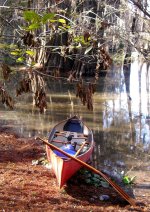I most often paddle kneeling but whether kneeling or sitting my navel winds up being very close the the longitudinal center line of a canoe with a symmetrical water footprint. Even when sitting I am planting my forward paddle stroke in front of the widest part of the canoe. When kneeling I am planting the stroke farther forward still. So I am not facing a wider gunwale beam at the initial part of my stroke, quite the opposite. That is even more so for a canoe with a swedeform hull design.
This is an excellent point for a narrow solo canoe with a centralized seating position.
I suppose I began this somewhat technical topic because the only canoe I've paddled all season is my pudgy (15' x 35") NC Bob Special from the bow seat backwards, an unusual and uncomfortable paddling position for me. It was this paddling position, with pronounced widening gunwales fore of me and narrowing gunwales aft, that made me think of the "dispute" about paddling parallel to the keel line vs. along the gunwale line, which arises mostly when soloing tandem canoes.
Historically, I mostly never faced this dispute because my daily driver flatwater solo canoe for 23 years, a Lotus Caper, has parallel gunwales all along the paddling station. So, paddling that canoe parallel to the keel line is exactly the same as paddling along the gunwale line.

(In Sparkleberry Swamp)
One final point about this dispute when you are situated between narrowing gunwales:
I believe the observation that following the gunwales will tend to turn you more to the off-side "because it is like a sweep stroke" is an observational illusion. I don't think it's the paddle travel along the narrowing gunwale that is enhancing the off-side yaw; rather, it's the tendency of paddlers to end their strokes with the wrong blade pitch. Paddlers who tend to turn their grip thumb slightly up while following a narrowing gunwale during the last half of the stroke will have have a blade pitch that enhances off-side yaw. For example, righty paddlers who end forward strokes with blade pitched like this, \ , will be worsening off-side yaw. They should end the stroke with (grip thumb down) blades pitched like this, /, which will reduce or even cancel the off-side yaw.
In conclusion, if two paddlers keep their blade faces at 90° to the keel line (unpitched) throughout their complete forward strokes—so blade pitch can't affect yaw—the paddler who draws along the narrowing keel line will induce slightly less off-side yaw than the paddler who draws parallel to the keel line, because paddling increasingly closer to the keel line produces less off-side yaw leverage. Whether this difference will be noticeable depends on the shape of the canoe, the seating position, and the amount of gunwale narrowing. It is noticeable to me when paddling bow backwards in the 15' x 35" Bob Special.
